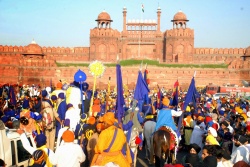Delhi Fateh Divas: Difference between revisions
Hari singh (talk | contribs) (Created page with "{{P|File:Delhi Fateh Diwas.JPG|Sikhs and others gather to celebrate the anniversary of the conquest of the Red Fort by Bhai Baghel Singh in 1783}} The Delhi Sikh Gurdwara Man...") |
Hari singh (talk | contribs) |
||
| Line 22: | Line 22: | ||
*[[Gurdwara Mata Sundri]] | *[[Gurdwara Mata Sundri]] | ||
*[[Gurdwara Bangla Sahib]], Delhi | *[[Gurdwara Bangla Sahib]], Delhi | ||
* | *[[Gurdwara Bala Sahib]], Delhi | ||
*[[Gurdwara Rakab Ganj Sahib|Gurdwara Rakab Ganj]], Delhi | *[[Gurdwara Rakab Ganj Sahib|Gurdwara Rakab Ganj]], Delhi | ||
*[[Gurdwara Sis Ganj Sahib|Gurdwara Sis Ganj]], Delhi | *[[Gurdwara Sis Ganj Sahib|Gurdwara Sis Ganj]], Delhi | ||
*[[Gurdwara Moti Bagh]], Delhi | *[[Gurdwara Moti Bagh]], Delhi | ||
* | *[[Gurdwara Majnu Ka Tilla]], Delhi | ||
Bhai Baghel Singh constructed seven gurdwaras. He maintained good law and order. His horses patrolled the city streets day and night. The citizen saw the kind of peace and order which they had not experienced for decades. The construction of seven gurdwaras was completed in about seven months, as stipulated in the agreement and he retired from the capital in early December 1783. At the time he had sufficient force in the city and was enjoying great prestige and goodwill of the public. He had the necessary force and could have decided to stay on and continue his control of the city. He stood by the agreement and left Delhi at the end of the stipulated period. | Bhai Baghel Singh constructed seven gurdwaras. He maintained good law and order. His horses patrolled the city streets day and night. The citizen saw the kind of peace and order which they had not experienced for decades. The construction of seven gurdwaras was completed in about seven months, as stipulated in the agreement and he retired from the capital in early December 1783. At the time he had sufficient force in the city and was enjoying great prestige and goodwill of the public. He had the necessary force and could have decided to stay on and continue his control of the city. He stood by the agreement and left Delhi at the end of the stipulated period. | ||
Revision as of 23:06, 11 April 2015
The Delhi Sikh Gurdwara Management Committee (DSGMC) has demanded that the Centre announce the “conquest of Lal Qila by the Sikh forces in 1783 as a national event celebrated annually”. The official demanded that the day be celebrated as ‘Delhi Fateh Diwas’ as the conquest paved the end of the mighty Mughal rule in India and beginning of war for Independence, a statement from the DSGMC said.
Officials said the committee is all set to celebrate the Fateh Diwas on March 21 and 22. This is the second year that the committee is holding the event – which commemorates unfurling of the Khalsa flag over Lal Qila in 1783 by Baba Baghel Singh.
“The efforts are being made to make it an annual program and we want that the Government of India also to commemorate the day,” said president of DSGMC Manjit Singh GK.
“DSGMC started celebrating Delhi Fateh Siwas last year, 2014. The fact that Sikhs conquered Lal Qila defeating the powerful Mughal rule remains unknown. It should be made a national event by the government,” said DSGMC general secretary Manjinder Singh Sirsa, also suggesting that the light and sound show at the Lal Qila every evening should include this historical fact.
History
- Main article: Bhai_Baghel_Singh#Battle_of_Ghanaur
Battle of Ghanaur
In 1778 the Mughal emperor Shah Alam II sent an estimated army of 100,000 soldiers to chastise the Sikhs. The Mughal force was commanded by the wazir Nawab Majad ud Daula under the banner of the crown prince. In addition to being a brave warrior, Baghel Singh was a sharp strategist and statesman. He was able to out-manoeuvre the strong Mughal army in the battle of Ghanaur, near Patiala city. As a result of the victory, the huge Mughal army surrendered before Baghel Singh's forces.
Baba Baghel Singh is credited with establishment of following Gurudwaras or Sikh Temples in Delhi:
- Gurdwara Mata Sundri
- Gurdwara Bangla Sahib, Delhi
- Gurdwara Bala Sahib, Delhi
- Gurdwara Rakab Ganj, Delhi
- Gurdwara Sis Ganj, Delhi
- Gurdwara Moti Bagh, Delhi
- Gurdwara Majnu Ka Tilla, Delhi
Bhai Baghel Singh constructed seven gurdwaras. He maintained good law and order. His horses patrolled the city streets day and night. The citizen saw the kind of peace and order which they had not experienced for decades. The construction of seven gurdwaras was completed in about seven months, as stipulated in the agreement and he retired from the capital in early December 1783. At the time he had sufficient force in the city and was enjoying great prestige and goodwill of the public. He had the necessary force and could have decided to stay on and continue his control of the city. He stood by the agreement and left Delhi at the end of the stipulated period.
In the News
The 2nd annual Delhi Fateh Diwas of 1783 was celebrated by Sikh Sangat in New Delhi with a lot of joy. The 2nd day of the celebrations saw a “Khalsai March” where Nihang Singhs, Gatka groups, Sikh army personnel and Sikh Sangat participated. The event organized by the Delhi Sikh…
See also
References
- 1. Gian Singh, Giani, Panth Prakash [Reprint]. Patiala, 1970
- 2. Bhahgu, Ratan Singh, Prachin Panth Prakash [Reprint], Amritsar, 1962
- 3. Sital, Sohan Singh, Sikh Mislan. Ludhiana, 1952
- 4. Gupta, Hari Ram, History of the Sikhs, vol. III. Delhi, 1979
- 5. Harbans Singh, The Heritage of the Sikhs. Delhi, 1983

